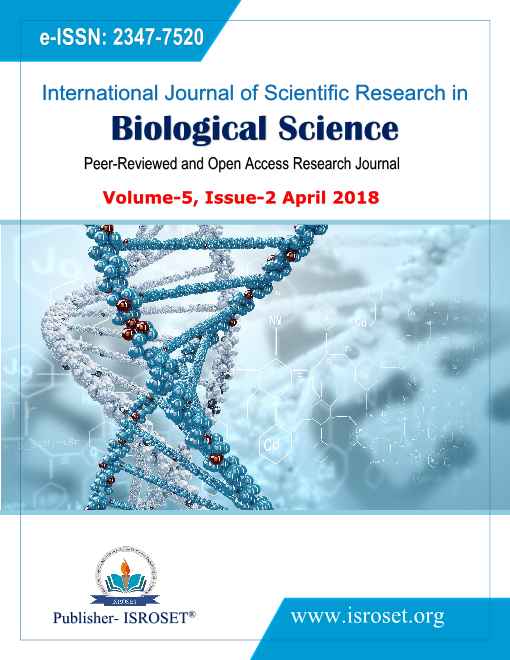3D structure prediction of OCT 4, an important Reprogramming Factor of induced Pluripotent Stem Cells (iPSCs)
Keywords:
iPSCs, therapeutic targets, homology modeling, template, reprogramming factors, OCT 4Abstract
Oct 4 is one of the transcription factors among six reprogramming factors (OCT4, SOX2, KLF4, C-MYC, NANOG, and LIN28) selected by Takahashi and Yamanaka to induce somatic cells into pluripotent stem cells (iPSCs).Stem cell research is used in treatment of a number of diseases including genetic disorders. Several questions regarding reprogramming factors of stem cells are remaining unanswerable due to limited experimental availability and ehilical issues. Proteomic analysis of OCT 4 is still remaining unpredicted as protein structure is not available in PDB. The aim of this study was prediction of the tertiary structure of OCT4 protein using homology modeling approach through MODELLER program. Quality and reliability assessments were performed on predicted model and found the model reliable.
References
H. M. Berman, J. Westbrook, Z. Feng, G. Gilliland, T. N. Bhat, et al, “The protein data bank”, Nucleic Acids Research, Vol. 28, pp. 235–242, 2000.
M.D. Bethesda, “Stem Cell Information”, National Institutes of Health. 2017.
V. Brendel, P. Bucher, I. Nourbakhsh, B. E. Blaisdell, S. Karlin, “Methods and algorithms for statistical analysis of protein sequences”. Proceedings of the National Academy of Sciences of the United States of America, Vol. 89, pp. 2002–2006, 1992.
W. L. DeLano, The PyMOL molecular graphics System, 2002.
N. Eswar, M.A. Marti-Renom, B. Webb, M.S. Madhusudhan, D. Eramian, et al. “Comparative Protein Structure Modeling with MODELLER”, Current Protocols in Bioinformatics, Vol .15, pp. 5.6.1-5.6.30, 2006.
A. Fiser, R.K. Do, A. Sali, 2000. “Modeling of loops in protein structures”, Protein Science. Vol. 9. pp. 1753-1773, 2000.
E. Gasteiger, C. Hoogland, A. Gattiker, S. Duvaud, M.R.Wilkins, A. Bairoch, 2005.”Protein Identification and Analysis Tools on the ExPASy Server;(In) John M. Walker (ed)”, The Proteomics Protocols Handbook, Humana Press. pp. 571-607, 2005.
K. Guruprasad, B.V.P. Reddy, M.W. Pandit, 1990. “Correlation between stability of a protein and its dipeptide composition: a novel approach for predicting in vivo stability of a protein from its primary sequence”. Prot. Eng, Vol. 4, pp. 155-164, 1990.
J. C. Hisstock, A.M. Lesk, “Prediction of protein function from sequence and structure”. Q Rev Biophys, Vol. 36, pp. 307-340, 2003.
K. Takahashi, et al. “Induction of pluripotent stem cells from adult human fibroblasts by defined factors”, Cell , Vol. 131, pp. 861–72, 2007.
K. Takahashi, S. Yamanaka, “Induction of pluripotent stem cells from mouse embryonic and adult fibroblast cultures by defined factors”, Cell Vol. 126, pp. 663–76, 2006.
H. Zaehres, H .R. Scholer, “Induction of pluripotency: from mouse to human”. Cell, Vol. 131, pp. 834–5. 2007.
M. Tada, Y. Takahama, K. Abe, N. Namatsuji, T. Tada, “Nuclear reprogramming of somatics cells by in vitro hybridization with ES cells”, Current biology, Vol. 11, pp. 1553-1558. 2001.
J. Yu, M.A. Vodyanik, K. Smuga-Otto,et al, “Induced pluripotent stem cell lines derived from human somatic cells”, Science, Vol. 5858, pp.1917–20, 2007.
K. Okita, T. Ichisaka, S. Yamanaka, “Generation of germline-‐competent induced pluripotent stem cells”. Nature, Vol. 448, pp.313-317, 2007.
N. Yokoo, et al, “The effects of cardiovactive drugs on cardiomyocytes derived from human induced pluripotent stem cells”. Biochem Biophys Res Commun , Vol. 387, pp.482-88, 2009.
Q. Lian, et al, “Future perspective of induced pluripotent stem cells for diagnosis, drug screening and treatment of human diseases”, Thromb Haemost, Vol. 104, pp.39-44, 2010.
E. A. Kimbrel, R. Lanza, “Pluripotent stem cells: The last 10 years”, Regenerative Medicine, Vol. 11, pp. 831–847, 2016.
Notredame, Higgins, Heringa,” T-Coffee: A novel method for multiple sequence alignments”, JMB, Vol. 302, pp. 205-217, 2000.
B.G. Rost, B.G. Yachdav, J. Liu,”The PredictProtein Server”, Nucleic Acids Research, 32(Web Server issue), W 321-W326.2004.
E. W. Sayers, T. Barrett, D.A. Benson, E. Bolton, S.H. Bryant, et al. “Database resources of the national center for bio- technology information”, Nucleic Acids Research, Vol. 39, pp. 38–51, 2011.
M.Y. Shen, A. Sali, “Statistical potential for assessment and prediction of protein structures”, 2006.
M.J. Sippl, “Recognition of Errors in Three-Dimensional Structures of Proteins”, Proteins, Vol. 17, pp. 355-362, 1993.
M. Stadtfeld, K. Hochedlinger, “Induced pluripotency: history, mechanisms, and applications”, Genes Dev, Vol. 4, pp. 2239–2263, 2010.
H. Ashkenazy, E. Erez, E. Martz, T. Pupko, N. Ben-Tal, Nucleic Acids Research, Vol. 38, W529– W533. 2010.
F. Glaser, T. Pupko, I. Paz, R. E. Bell, D. Bechor-Shental, E. Martz, N. Ben-Tal, Bioinformatics, Vol. 19, pp. 163–164, 2003.
W.L. DeLano, “The PyMOL molecular graphics System”, 2002.
M.Y.Shen and A. Sali, “Statistical Potential For Assessment and prediction of Protein Structures”, Protein Sci, Vol. 15, pp. 2507–2524.2006.
M. Wiederstein, J. Sippl, “ProSA-web: Interactive Web Service for the Recognition of Errors in Three-dimensional Structures of Proteins”, Nucleic Acids Research, Vol. 35, W407-W410. 200
Downloads
Published
How to Cite
Issue
Section
License

This work is licensed under a Creative Commons Attribution 4.0 International License.
Authors contributing to this journal agree to publish their articles under the Creative Commons Attribution 4.0 International License, allowing third parties to share their work (copy, distribute, transmit) and to adapt it, under the condition that the authors are given credit and that in the event of reuse or distribution, the terms of this license are made clear.







